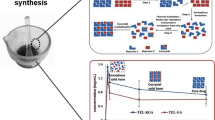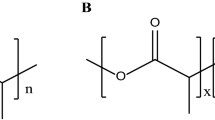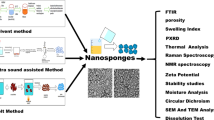Abstract
Hydrogel biocomposites containing a combination of graphene oxide (GO) and natural polymer-based copolymer of sodium alginate (Alg) and acrylic acid (AAc) were prepared by radiation-induced copolymerization and crosslinking. FTIR, XRD, and AFM analyses revealed the successful preparation of single-layered graphene oxide sheets. FTIR and TGA data confirmed the incorporation of GO within the (AAc-co-Alg) copolymer hydrogel. The effect of GO content, as interpenetrating network, on the swelling behavior of (AAc-co-Alg) copolymer hydrogel was investigated. The results of the pH-dependent swelling showed the presence of GO within the prepared hydrogel improve the ability of the GO/(AAc-co-Alg) nanocomposite hydrogel to bypass the acidity of the simulated stomach medium (pH 1) without significant swelling and regulate it for longer period in simulated intestine medium (pH 7). Moreover, the swelling kinetics showed that all the samples under investigation possess Fickian at pH 1 and non-Fickian at pH 7. The evaluation of the prepared GO/(AAc-co-Alg) nanocomposite hydrogel as drug carrier was carried out in either simulated stomach and intestine media using cefadroxil as a model drug. The drug release profile came in a good agreement with swelling results which recommend the GO/(AAc-co-Alg) nanocomposite hydrogel as potential targeted drug delivery system.








Similar content being viewed by others
References
Wegrzyn M, Galindo B, Benedito A, Gimenez E (2015) Morphology, thermal, and electrical properties of polypropylene hybrid composites co-filled with multi-walled carbon nanotubes and graphene nanoplatelets. J Appl Polym Sci 132(46):42793-1–42793-8. doi:10.1002/app.42793
Reddy KR, Hassan M, Gomes VG (2015) Hybrid nanostructures based on titanium dioxide for enhanced photocatalysis. Appl Catal A 489:1–16. doi:10.1016/j.apcata.2014.10.001
Choi SH, Kim DH, Raghu AV, Reddy KR, Lee H-I, Yoon KS, Jeong HM, Kim BK (2012) Properties of graphene/waterborne polyurethane nanocomposites cast from colloidal dispersion mixtures. J Macromol Sci Part B 51(1):197–207. doi:10.1080/00222348.2011.583193
Puri P, Mehta R, Rattan S (2015) Synthesis of conductive polyurethane/graphite composites for electromagnetic interference shielding. J Electron Mater 44(11):4255–4268. doi:10.1007/s11664-015-4004-1
Zhou Q, Ye X, Wan Z, Jia C (2015) A three-dimensional flexible supercapacitor with enhanced performance based on lightweight, conductive graphene-cotton fabric electrode. J Power Sources 296:186–196. doi:10.1016/j.jpowsour.2015.07.012
Lan Z, Gao S, Wu J, Lin J (2015) High-performing dye-sensitized solar cells based on reduced graphene oxide/PEDOT-PSS counter electrodes with sulfuric acid post-treatment. J Appl Polym Sci 132(41):42648-1–42648-5. doi:10.1002/app.42648
Gupta S, Carrizosa SB (2015) Graphene-inorganic hybrids with cobalt oxide polymorphs for electrochemical energy systems and electrocatalysis: synthesis, processing and properties. J Electron Mater 44(11):4492–4509. doi:10.1007/s11664-015-4016-x
Wu R, Wang Y, Chen L, Huang L, Chen Y (2015) Control of the oxidation level of graphene oxide for high efficiency polymer solar cells. Rsc Adv 5(61):49182–49187. doi:10.1039/c5ra02099a
Kim F, Cote LJ, Huang J (2010) Graphene oxide: surface activity and two-dimensional assembly. Adv Mater 22(17):1954–1958. doi:10.1002/adma.200903932
Robinson JT, Tabakman SM, Liang Y, Wang H, Sanchez Casalongue H, Vinh D, Dai H (2011) Ultrasmall reduced graphene oxide with high near-infrared absorbance for photothermal therapy. J Am Chem Soc 133(17):6825–6831. doi:10.1021/ja2010175
Han SJ, Lee H-I, Jeong HM, Kim BK, Raghu AV, Reddy KR (2014) Graphene modified lipophilically by stearic acid and its composite with low density polyethylene. J Macromol Sci Part B 53(7):1193–1204. doi:10.1080/00222348.2013.879804
El-Hag Ali A, Abd El-Rehim HA, Hegazy E-SA, Ghobashy MM (2006) Synthesis and electrical response of acrylic acid/vinyl sulfonic acid hydrogels prepared by γ-irradiation. Radiat Phys Chem 75(9):1041–1046. doi:10.1016/j.radphyschem.2005.05.022
El-Hag Ali Said A (2005) Radiation synthesis of interpolymer polyelectrolyte complex and its application as a carrier for colon-specific drug delivery system. Biomaterials 26(15):2733–2739. doi:10.1016/j.biomaterials.2004.07.049
Sirc J, Hrib J, Vetrik M, Hobzova R, Zak A, Stankova B, Slanar O, Hromadka R, Sandrikova V, Michalek J (2015) The use of a hydrogel matrix for controlled delivery of niacin to the gastrointestinal tract for treatment of hyperlipidemia. Physiol Res/Academia Scientiarum Bohemoslovaca 64(Suppl 1):S51–S60
Schmaljohann D (2006) Thermo- and pH-responsive polymers in drug delivery. Adv Drug Deliv Rev 58(15):1655–1670. doi:10.1016/j.addr.2006.09.020
El-Hag Ali A, AlArifi A (2009) Characterization and in vitro evaluation of starch based hydrogels as carriers for colon specific drug delivery systems. Carbohydr Polym 78(4):725–730. doi:10.1016/j.carbpol.2009.06.009
Raafat AI (2010) Gelatin based pH-sensitive hydrogels for colon-specific oral drug delivery: synthesis, characterization, and in vitro release study. J Appl Polym Sci 118(5):2642–2649. doi:10.1002/app.32601
El-Hag Ali A, Abd El-Rehim HA, Kamal H, Hegazy DESA (2008) Synthesis of carboxymethyl cellulose based drug carrier hydrogel using ionizing radiation for possible use as site specific delivery system. J Macromol Sci Part A 45(8):628–634. doi:10.1080/10601320802168751
Wang J, Liu C, Shuai Y, Cui X, Nie L (2014) Controlled release of anticancer drug using graphene oxide as a drug-binding effector in konjac glucomannan/sodium alginate hydrogels. Colloids Surf B 113:223–229. doi:10.1016/j.colsurfb.2013.09.009
Rapoport N, Gupta R, Kim Y-S, O’Neill BE (2015) Polymeric micelles and nanoemulsions as tumor-targeted drug carriers: insight through intravital imaging. J Controll Releas 206:153–160. doi:10.1016/j.jconrel.2015.03.010
Sundar S, Mariappan R, Piraman S (2014) Synthesis and characterization of amine modified magnetite nanoparticles as carriers of curcumin-anticancer drug. Powder Technol 266:321–328. doi:10.1016/j.powtec.2014.06.033
Xue M, Hu S, Lu Y, Zhang Y, Jiang X, An S, Guo Y, Zhou X, Hou H, Jiang C (2015) Development of chitosan nanoparticles as drug delivery system for a prototype capsid inhibitor. Int J Pharm 495(2):771–782. doi:10.1016/j.ijpharm.2015.08.056
Bai H, Li C, Wang X, Shi G (2010) A pH-sensitive graphene oxide composite hydrogel. Chem Commun 46(14):2376–2378. doi:10.1039/C000051E
Sun S, Wu P (2011) A one-step strategy for thermal- and pH-responsive graphene oxide interpenetrating polymer hydrogel networks. J Mater Chem 21(12):4095. doi:10.1039/c1jm10276a
Miao W, Shim G, Kang CM, Lee S, Choe YS, Choi H-G, Oh Y-K (2013) Cholesteryl hyaluronic acid-coated, reduced graphene oxide nanosheets for anti-cancer drug delivery. Biomaterials 34(37):9638–9647. doi:10.1016/j.biomaterials.2013.08.058
Aderibigbe BA, Owonubi SJ, Jayaramudu J, Sadiku ER, Ray SS (2015) Targeted drug delivery potential of hydrogel biocomposites containing partially and thermally reduced graphene oxide and natural polymers prepared via green process. Colloid Polym Sci 293(2):409–420. doi:10.1007/s00396-014-3400-z
Dreyer DR, Park S, Bielawski CW, Ruoff RS (2010) The chemistry of graphene oxide. Chem Soc Rev 39(1):228–240. doi:10.1039/B917103G
Liao K-H, Mittal A, Bose S, Leighton C, Mkhoyan KA, Macosko CW (2011) Aqueous only route toward graphene from graphite oxide. ACS Nano 5(2):1253–1258. doi:10.1021/nn1028967
Kim H, Abdala AA, Macosko CW (2010) Graphene/polymer nanocomposites. Macromolecules 43(16):6515–6530. doi:10.1021/ma100572e
Choi KS, Liu F, Choi JS, Seo TS (2010) Fabrication of free-standing multilayered graphene and poly(3,4-ethylenedioxythiophene) composite films with enhanced conductive and mechanical properties. Langmuir 26(15):12902–12908. doi:10.1021/la101698j
Vadukumpully S, Paul J, Mahanta N, Valiyaveettil S (2011) Flexible conductive graphene/poly(vinyl chloride) composite thin films with high mechanical strength and thermal stability. Carbon 49(1):198–205. doi:10.1016/j.carbon.2010.09.004
Zhao X, Zhang Q, Hao Y, Li Y, Fang Y, Chen D (2010) Alternate multilayer films of poly(vinyl alcohol) and exfoliated graphene oxide fabricated via a facial layer-by-layer assembly. Macromolecules 43(22):9411–9416. doi:10.1021/ma101456y
Si Y, Samulski ET (2008) Synthesis of water soluble graphene. Nano Lett 8(6):1679–1682. doi:10.1021/nl080604h
Stankovich S, Dikin DA, Piner RD, Kohlhaas KA, Kleinhammes A, Jia Y, Wu Y, Nguyen ST, Ruoff RS (2007) Synthesis of graphene-based nanosheets via chemical reduction of exfoliated graphite oxide. Carbon 45(7):1558–1565. doi:10.1016/j.carbon.2007.02.034
Chandra S, Sahu S, Pramanik P (2010) A novel synthesis of graphene by dichromate oxidation. Mater Sci Eng B 167(3):133–136. doi:10.1016/j.mseb.2010.01.029
Yang X, Zhang X, Liu Z, Ma Y, Huang Y, Chen Y (2008) High-efficiency loading and controlled release of doxorubicin hydrochloride on graphene oxide. J Phys Chem C 112(45):17554–17558. doi:10.1021/jp806751k
Ionita M, Pandele MA, Iovu H (2013) Sodium alginate/graphene oxide composite films with enhanced thermal and mechanical properties. Carbohydr Polym 94(1):339–344. doi:10.1016/j.carbpol.2013.01.065
Goenka S, Sant V, Sant S (2014) Graphene-based nanomaterials for drug delivery and tissue engineering. J Control Release 173:75–88. doi:10.1016/j.jconrel.2013.10.017
Zhang J, Wang Q, Wang A (2010) In situ generation of sodium alginate/hydroxyapatite nanocomposite beads as drug-controlled release matrices. Acta Biomater 6(2):445–454. doi:10.1016/j.actbio.2009.07.001
Paredes JI, Villar-Rodil S, Martínez-Alonso A, Tascón JMD (2008) Graphene oxide dispersions in organic solvents. Langmuir 24(19):10560–10564. doi:10.1021/la801744a
Cárdenas G, Muñoz C, Carbacho H (2000) Thermal properties and TGA–FTIR studies of polyacrylic and polymethacrylic acid doped with metal clusters. Eur Polym J 36(6):1091–1099. doi:10.1016/S0014-3057(99)00187-1
Luo Y-L, Wei Q-B, Xu F, Chen Y-S, Fan L-H, Zhang C-H (2009) Assembly, characterization and swelling kinetics of Ag nanoparticles in PDMAA-g-PVA hydrogel networks. Mater Chem Phys 118(2–3):329–336. doi:10.1016/j.matchemphys.2009.07.063
Colombo P, Bettini R, Santi P, Peppas NA (2000) Swellable matrices for controlled drug delivery: gel-layer behaviour, mechanisms and optimal performance. Pharm Sci Technol Today 3(6):198–204. doi:10.1016/S1461-5347(00)00269-8
Ritger PL, Peppas NA (1987) A simple equation for description of solute release I. Fickian and non-fickian release from non-swellable devices in the form of slabs, spheres, cylinders or discs. J Controll Releas 5(1):23–36. doi:10.1016/0168-3659(87)90034-4
Author information
Authors and Affiliations
Corresponding author
Rights and permissions
About this article
Cite this article
Raafat, A.I., Ali, A.EH. pH-controlled drug release of radiation synthesized graphene oxide/(acrylic acid-co-sodium alginate) interpenetrating network. Polym. Bull. 74, 2045–2062 (2017). https://doi.org/10.1007/s00289-016-1818-9
Received:
Revised:
Accepted:
Published:
Issue Date:
DOI: https://doi.org/10.1007/s00289-016-1818-9




